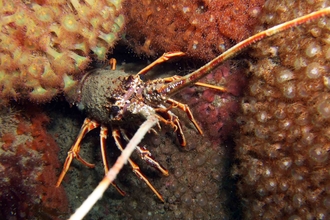
Great Scallop ©Paul Naylor/www.marinephoto.co.uk
Great scallop
Great scallops are found around much of the UK and are a favourite seafood for people and starfish alike!
Scientific name
Pecten maximusWhen to see
January to DecemberSpecies information
About
Great scallops are a large bivalve mollusc, its shell familiar to us all with its radiating ridges and characteristic scallop wings by the hinge. The 2 shells are actually different: one is curved like a bowl and the upper shell is flat like a lid. They live in a self-dug hollow on sandy or gravelly seabeds and are filter feeders, filtering out plankton and other micro-organisms. Scallops are a favourite food of starfish, but can actually swim out of harm's way by rapidly opening and shutting their shells, sending out jets of water which propel them over short distances.How to identify
Also known as the 'King scallop' or 'Common scallop', Great scallops are distinguished from all other scallops by their large size and symmetrical 'wings'. They are normally a pale orange colour on the outside and have obvious radiating ridges.Distribution
Found around the coasts of the UK, rarer on the East Coast.Did you know?
Scallops have around 200 small eyes all around their mantle. These eyes have a beautiful blue sheen and allow the Scallops to detect approaching predators. Scientists have recently discovered that these eyes use mirrors to see - just like in telescopes. Scientists now plan to use this discovery to improve our telescope technology. Cool, hey?How people can help
Choose diver-caught scallops rather than dredged scallops. The majority of UK caught scallops are exported abroad to European markets. Many vulnerable seabed habitats are now protected as Marine Protected Areas, where scallop dredging is prohibited. However, the UK network of Marine Protected Areas is not yet complete and many fragile habitats are still without protection. The Wildlife Trusts are campaigning for the designation of Marine Conservation Zones (MCZs) in English and offshore waters. You can join our campaign by becoming a Friend of MCZs at wildlifetrusts.org/mczfriends.



